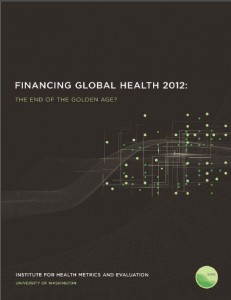
Drops in donor spending on global health in 2011 were not as steep as expected and were part of a shift, that while reflecting the impact of the global economic crisis, also indicated recognition of the need to support health and health systems worldwide.
This is the news that gives a nuanced answer to the question posed in the title of the latest report from the Institute for Health Metrics and Evaluation at the University of Washington, Financing Global Health 2012: The End of the Golden Age? In addition to collecting and analyzing information on donor spending, the report also presents data through 2010 on spending by governments on their own health related investments, and that expenditure to total 18 times the amount supplied by donors, even at the peak of development health assistance. And, while the total of government spending on health in sub-Saharan Africa was smaller than the total in other regions, it still was more than three and a half times higher than the total from donors.
With the future of funding from both sides unpredictable, the most compelling cautionary data is that showing drops for health sector support as well as for noncommunicable diseases, even during the previous decade of steep increases in other spending, and not reflecting the impact of the HIV epidemic or the noncommunicable disease burdens on health systems as well as populations.
The IHME plans to use updated information on disease impacts from the recent Global Burden of Disease 2010.
Source: Science Speaks